| Caliph خَليفة (khalīfah) | |
|---|---|
| Style | Amir al-Mu'minin |
| Residence | |
| Appointer | Hereditary (since 661) |
| Formation | 8 June 632 |
| First holder | |
| Abolished | 3 March 1924 |
A caliph is the supreme religious and political leader of an Islamic state known as the caliphate.[4][5] Caliphs led the Muslim Ummah as political successors to the Islamic prophet Muhammad,[6] and widely-recognised caliphates have existed in various forms for most of Islamic history.[7]
The first caliphate, the Rashidun Caliphate, was ruled by the four Rashidun caliphs (Arabic: الخلفاء الراشدون, lit. 'Rightly Guided Caliphs'), Abu Bakr, Umar, Uthman and Ali, who are considered by Sunni Muslims to have been the most virtuous and pure caliphs. They were chosen by popular acclamation or by a small committee, in contrast with the following caliphates, which were mostly hereditary.[8] On the other hand, Shiites only recognise Ali and consider the first three caliphs to be usurpers.
The Rashidun caliphate ended with the First Fitna, which transferred authority to the Umayyad dynasty that presided over the Umayyad Caliphate, the largest caliphate and the last one to actively rule the entire Muslim world.[9]
The Abbasid Revolution overthrew the Ummayads and instituted the Abbasid dynasty which ruled over the Abbasid Caliphate.[10] The Abbassid Caliphate was initially strong and united, but gradually fractured into several states whose rulers only paid lip service to the caliph in Baghdad. There were also rivals to the Abbasids who claimed the caliphates for themselves, such as the Isma'ili Shia Fatimids, the Sunni Ummayyads in Córdoba and the Almohads, who followed their own doctrine. When Baghdad fell to the Mongols, the Abbassid family relocated to Cairo, where they continued to claim caliphal authority but had no political power, and actual authority was in the hands of the Mamluk Sultanate.
After the Ottoman conquest of Egypt, the Abbasid caliph Al-Mutawakkil III was taken to Constantinople, where he surrendered the caliphate to the Ottoman Sultan Selim I. The caliphate then remained in the House of Osman until after the First World War. The Ottoman Sultanate was abolished in 1922 by the Grand National Assembly of Turkey. The head of the House of Osman, Abdulmejid II, retained the title of caliph for two more years, after which the caliphate was abolished in 1924.
Rashidun Caliphate (632–661)
| Calligraphic name | Name (in Arabic) | Born (CE) | Reigned from (CE) | Reigned until (CE) | Died | Relationship with Muhammad | House |
|---|---|---|---|---|---|---|---|
 |
Abu Bakr (أبو بكر الصديق) |
573 | 8 June 632 | 22 August 634 |
Father of Aisha, Muhammad's wife |
Banu Taim | |
 |
Umar (عمر بن الخطاب) |
584 | 23 August 634 | 3 November 644 (assassinated while praying by Abu Lu'lu'a Firuz) |
Father of Hafsa, Muhammad's wife |
Banu Adi | |
.JPG.webp) |
Uthman (عثمان بن عفان) |
579 | 11 November 644 | 20 June 656 (assassinated at the end of a siege upon his house; see First Fitna) |
Husband of Muhammad's daughters, Ruqayya and later Umm Kulthum, and grandson of Muhammad's paternal aunt |
Banu Ummaya | |
.JPG.webp) |
Ali (علي بن أبي طالب) |
601 | 20 June 656 | 29 January 661 (assassinated while praying in the Mosque of Kufa; see First Fitna) |
Muhammad's cousin, and husband of Fatimah, Muhammad's daughter, and Umamah bint Zainab, Muhammad's granddaughter |
Banu Hashim | |
Hassan ibn Ali's Caliphate (661)
There is difference of opinion on whether Hasan ibn Ali, who succeeded his father for a few months before abdicating in favor of Mu'awiya I in the Hasan–Muawiya treaty, should be considered one of the Rashidun caliphs.
| Calligraphic name | Name (in Arabic) | Born (CE) | Reign (CE) | Death | Relationship with Muhammad (or previous Caliph) | House |
|---|---|---|---|---|---|---|
.jpg.webp) |
Hasan ibn Ali (الحسن بن علي) Ahl al-Bayt Al-Mujtaba |
624 | Six or seven months during 661 | 670 | Muhammad's grandson through his daughter Fatima
Son of Ali |
Banu Hashim |
Umayyad Caliphate (661–750)
| Image/Coin | Name | Born | Reigned from | Reigned until | Died | Relation with predecessor |
|---|---|---|---|---|---|---|
.jpg.webp) |
Mu'awiya I | 602 | 661 | 29 April or 1 May 680 |
Second cousin of Uthman | |
 |
Yazid I | 647 | 680 | 11 November 683 |
Son of Mu'awiya I | |
 |
Mu'awiya II | 664 | November 683 | 684 |
Son of Yazid I | |
 |
Marwan I | 623–626 | 684 | 7 May 685 |
First cousin of Uthman | |
 |
Abd al-Malik ibn Marwan | 646 | 685 | 8 October 705 |
Son of Marwan I | |
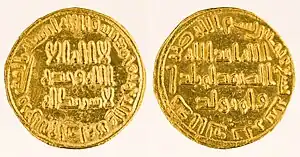 |
Al-Walid I | 668 | October 705 | 23 February 715 |
Son of Abd al-Malik ibn Marwan | |
 |
Sulayman ibn Abd al-Malik | 674 | February 715 | 22 September 717 |
Son of Abd al-Malik Brother of al-Walid I | |
 |
Umar II | 2 November 682 | September 717 | February 720 |
Nephew of Abd al-Malik First cousin of Al-Walid I and Sulayman Great-grandson of Umar through a maternal line | |
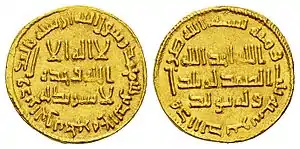 |
Yazid II | 687 | 10 February 720 | 26 January 724 |
Son of Abd al-Malik Brother of al-Walid I and Sulayman | |
 |
Hisham ibn Abd al-Malik | 691 | 26 January 724 | 6 February 743 |
Son of Abd al-Malik Brother of al-Walid I, Sulayman and Yazid II | |
 |
Al-Walid II | 709 | 6 February 743 | 17 April 744 (assassinated) |
Son of Yazid II | |
 |
Yazid III | 701 | 17 April 744 | 3/4 October 744 |
Son of Al-Walid I | |
 |
Ibrahim ibn al-Walid | 744 (few weeks) | 25 January 750 (executed) |
Son of Al-Walid I | ||
 |
Marwan II | 691 | 744 | 6 August 750 (killed) |
Nephew of Abd al-Malik Cousin of Al-Walid I, Sulayman, Umar II, Yazid II and Hisham. | |
Abbasid Caliphate (750–1258)
| Coin | Regnal name | Personal name | Born | Reigned from | Reigned until | Died | Parents |
|---|---|---|---|---|---|---|---|
 |
Al-Sāffaḥ | Abul-'Abbās 'Abdallah | 721 | 25 January 750 | 10 June 754 |
| |
.JPG.webp) |
Al-Mansur | Abu Ja'far 'Abdallah | 714 | 10 June 754 | 775 | ||
 |
Al-Mahdi | Abu 'Abdallah Muhammad | 744/745 | 775 | 4 August 785 |
| |
| Al-Hadi | Abu Muhammad Musa | 764 | August 785 | 14 September 786 |
| ||
 |
Al-Rashid | Harun | 763/766 | 14 September 786 | 24 March 809 |
| |
.jpg.webp) |
Al-Amin | Muhammad | 787 | March 809 | 24/25 September 813 |
| |
| Al-Ma'mun | Abu al-Abbas 'Abdallah | 13/14 September 786 | September 813 | 9 August 833 |
| ||
| Al-Mu'tasim | Abū Ishaq Muhammad | October 796 | 9 August 833 | 5 January 842 |
| ||
| Al-Wathiq | Abu Ja'far Harun | 811–813 | 5 January 842 | 10 August 847 |
| ||
| Al-Mutawakkil | Ja'far | February/March 822 | 10 August 847 | 11 December 861 (assassinated) |
| ||
 |
Al-Muntasir | Abu Ja'far Muhammad | November 837 | 861 | 7 or 8 June 862 |
| |
 |
Al-Musta'in | Ahmad | 836 | 862 | 866 (executed) |
| |
| Al-Mu'tazz | Abū ʿAbd allāh Muhammad | 847 | 866 | 869 |
| ||
| Al-Muhtadi | Abū Isḥāq Muḥammad | 869 | 21 June 870 |
| |||
| Al-Mu'tamid | Abu’l-ʿAbbās Aḥmad | 842 | 21 June 870 | 15 October 892 |
| ||
| Al-Mu'tadid | Abu'l-'Abbas Ahmad | 854/861 | October 892 | 5 April 902 |
| ||
| Al-Muktafi | Abu Muhammad ʿAlî | 877/878 | 5 April 902 | 13 August 908 |
| ||
| Al-Muqtadir | Abu al-Fadl Ja'far | 895 | 13 August 908 | 929 | 31 October 932 (killed) |
| |
| Al-Qahir | Abu Mansur Muhammad | 899 | 929 | 950 |
| ||
| Al-Muqtadir | Abu al-Fadl Ja'far | 895 | 929 | 31 October 932 (killed) |
| ||
| Al-Qahir | Abu Mansur Muhammad | 899 | 31 October 932 | 934 | 950 |
| |
| Al-Radi | Abu al-'Abbas Muhammad | December 909 | 934 | 23 December 940 |
| ||
| Al-Muttaqi | Abu Ishaq Ibrahim | 908 | 940 | 944 | July 968 |
| |
 |
Al-Mustakfi | Abu’l-Qasim 'Abdallah | 905 | September 944 | January 946 | September/October 949 |
|
| Al-Muti | Abu al-Qasim al-Faḍl | 914 | January 946 | 5 August 974 | 12 October 974 |
| |
| Al-Ta'i' | Abd al-Karīm | 932 | 974 | 991 | 3 August 1003 |
| |
| Al-Qadir | Abu'l-Abbas Ahmad ibn Ishaq ibn al-Muqtadir | 947 | 1 November 991 | 29 November 1031 |
| ||
 |
Al-Qa'im | Abu Ja'far Abdallah | 1001 | 29 November 1031 | 2 April 1075 |
| |
 |
Al-Muqtadi | Abū'l-Qāsim ʿAbd Allāh ibn Muhammad ibn al-Qa'im | 1056 | 2 April 1075 | February 1094 |
| |
 |
Al-Mustazhir | Abū l-ʿAbbās Ahmad | April/May 1078 | February 1094 | 6 August 1118 |
| |
| Al-Mustarshid | Abū'l-Manṣūr al-Faḍl | April/May 1092 | 6 August 1118 | 29 August 1135 |
| ||
| Al-Rashid Billah | Abu Jaʿfar Manṣūr | 1109 | 29 August 1135 | 1136 | 6 June 1138 (killed by Hashshashins) |
| |
| Al-Muqtafi | Abū ʿAbd Allāh Muḥammad | 9 March 1096 | 1136 | 12 March 1160 |
| ||
 |
Al-Mustanjid | Abū'l-Muẓaffar Yūsuf | 1124 | 12 March 1160 | 20 December 1170 |
| |
 |
Al-Mustadi | Hassan | 1142 | 20 December 1170 | 30 March 1180 |
| |
 |
Al-Nasir | Abu'l-ʿAbbās Ahmad | 6 August 1158 | 2 March 1180 | 4 October 1225 |
| |
| Al-Zahir | Abu Nasr Muhammad | 1176 | 5 October 1225 | 11 July 1226 |
| ||
| Al-Mustansir | Abû Ja`far al-Manṣūr | 17 February 1192 | 11 July 1226 | 2 December 1242 |
| ||
 |
Al-Musta'sim | Abu Ahmad Abdallah | 1213 | 2 December 1242 | 20 February 1258 |
| |
During the later period of Abbasid rule, Muslim rulers began using other titles, such as Amir al-umara and Sultan.
Mamluk Abbasid dynasty (1261–1517)
The Cairo Abbasids were largely ceremonial Caliphs under the patronage of the Mamluk Sultanate that existed after the takeover of the Ayyubid dynasty.[11][12]
| Regnal name | Personal name | Reign | Parents |
|---|---|---|---|
| Al-Mustansir | Abu al-Qasim Ahmad | 13 June 1261 – 28 November 1261 | |
| Al-Hakim I | Abu 'Abdullah Muhammad | 16 November 1262 – 19 January 1302 |
|
| Al-Mustakfi I | Abu ar-Rabi' Sulaiman | 20 January 1302 – February 1340 | |
| Al-Wathiq I | Abu Ishaq Ibrahim | February 1340 – 17 June 1341 |
|
| Al-Hakim II | Abu al-'Abbas Ahmad | 1341–1352 | |
| Al-Mu'tadid I | Abu Bakr | 1352–1362 | |
| Al-Mutawakkil I | Abu 'Abdillah Muhammad | 1362–1377 | |
| Al-Musta’sim | Abu Yahya Zakariya | 1377 | |
| Al-Mutawakkil I | Abu 'Abdillah Muhammad | 1377–1383 | |
| Al-Wathiq II | 'Umar | September 1383 – 13 November 1386 | |
| Al-Musta'sim | Abu Yahya Zakariya | 1386–1389 | |
| Al-Mutawakkil I | Abu 'Abdillah Muhammad | 1389 – 9 January 1406 | |
| Al-Musta'in | Abu al-Fadl al-'Abbas | 22 January 1406 – 9 March 1414 |
|
| Al-Mu'tadid II | Abu al-Fath Dawud | 1414–1441 |
|
| Al-Mustakfi II | Abu ar-Rabi' Sulayman | 1441 – 29 January 1451 | |
| Al-Qa'im | Abu Al-Baqa Hamzah | 1451–1455 | |
| Al-Mustanjid | Abu al-Mahasin Yusuf | 1455 – 7 April 1479 | |
| Al-Mutawakkil II | Abu al-'Izz 'Abdul 'Aziz | 5 April 1479 – 27 September 1497 |
|
| Al-Mustamsik | Abu as-Sabr | 1497–1508 | |
| Al-Mutawakkil III | Muhammad | 1508–1516 | |
| Al-Mustamsik | Abu as-Sabr | 1516–1517 | |
| Al-Mutawakkil III | Muhammad | 1517 |
Ottoman Caliphate (1517–1924)
The head of the Ottoman dynasty was just entitled Sultan originally, but soon it started accumulating titles assumed from subjected peoples.[13][14] Murad I (reigned 1362–1389) was the first Ottoman claimant to the title of Caliph; claimed the title after conquering Edirne.[15]
| Image | Tughra | Name | Reign | Parents |
|---|---|---|---|---|
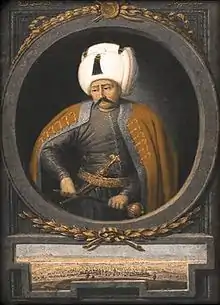 |
Tughra of Selim I |
Selim I | 1517 – 21 September 1520 | |
 |
 Tughra of Suleiman I |
Suleiman I | 30 September 1520 – 6 or 7 September 1566 |
|
 |
Tughra of Selim II |
Selim II | 29 September 1566 – 21 December 1574 |
|
 |
 Tughra of Murad III |
Murad III | 22 December 1574 – 16 January 1595 |
|
 |
Tughra of Mehmed III |
Mehmed III | 27 January 1595 – 20 or 21 December 1603 |
|
 |
Tughra of Ahmed I |
Ahmed I | 21 December 1603 – 22 November 1617 |
|
.jpg.webp) |
Tughra of Mustafa I |
Mustafa I | 22 November 1617 – 26 February 1618 | |
 |
Tughra of Osman II |
Osman II | 26 February 1618 – 19 May 1622 |
|
.jpg.webp) |
Tughra of Mustafa I |
Mustafa I | 20 May 1622 – 10 September 1623 | |
 |
Tughra of Murad IV |
Murad IV | 10 September 1623 – 8 or 9 February 1640 |
|
 |
Tughra of Ibrahim |
Ibrahim | 9 February 1640 – 8 August 1648 | |
.jpg.webp) |
Tughra of Mehmed IV |
Mehmed IV | 8 August 1648 – 8 November 1687 |
|
 |
Tughra of Suleiman II |
Suleiman II | 8 November 1687 – 22 June 1691 |
|
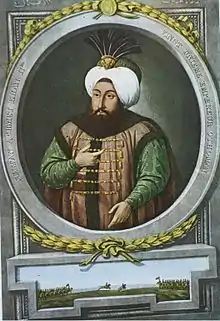 |
Tughra of Ahmed II |
Ahmed II | 22 June 1691 – 6 February 1695 |
|
 |
Tughra of Mustafa II |
Mustafa II | 6 February 1695 – 22 August 1703 |
|
 |
Tughra of Ahmed III |
Ahmed III | 22 August 1703 – 1 or 2 October 1730 |
|
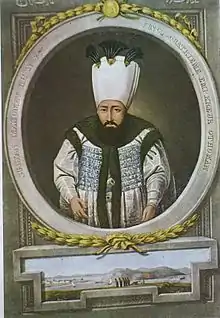 |
Tughra of Mahmud I |
Mahmud I | 2 October 1730 – 13 December 1754 |
|
 |
Tughra of Osman III |
Osman III | 13 December 1754 – 29 or 30 October 1757 |
|
 |
Tughra of Mustafa III |
Mustafa III | 30 October 1757 – 21 January 1774 |
|
 |
Tughra of Abdülhamid I |
Abdul Hamid I | 21 January 1774 – 6 or 7 April 1789 |
|
 |
Tughra of Selim III |
Selim III | 7 April 1789 – 29 May 1807 |
|
 |
 Tughra of Mustafa IV |
Mustafa IV | 29 May 1807 – 28 July 1808 |
|
 |
Tughra of Mahmud II |
Mahmud II | 28 July 1808 – 1 July 1839 |
|
 |
Tughra of Abdülmecid I |
Abdulmejid I | 1 July 1839 – 25 June 1861 |
|
 |
 Tughra of Abdulaziz |
Abdulaziz | 25 June 1861 – 30 May 1876 |
|
 |
 Tughra of Murad V |
Murad V | 30 May 1876 – 31 August 1876 |
|
 |
 Tughra of Abdülhamid II |
Abdul Hamid II | 31 August 1876 – 27 April 1909 |
|
 |
 Tughra of Mehmed V |
Mehmed V | 27 April 1909 – 3 July 1918 |
|
 |
 Tughra of Mehmed VI |
Mehmed VI | 4 July 1918 – 1 November 1922 |
|
 |
— [nb 1] |
Abdulmejid II | 18 November 1922 – 3 March 1924 |
|
The Office of the Ottoman Caliphate was transferred to the Grand National Assembly of Turkey which dissolved the office on March 3, 1924, in keeping with the policies of secularism that were adopted in the early years of the Republic of Turkey by its President Mustafa Kemal Atatürk.
After the abolition of the Caliphate, the Grand National Assembly of Turkey founded the Presidency of Religious Affairs as the new highest Islamic religious authority in the country.
Other caliphates
Abd Allah ibn al-Zubayr's Caliphate (684–692)
Abd Allah ibn al-Zubayr, the nephew of Aisha, the third wife of Muhammad, led a rebellion against the Umayyad Caliphate in 684 AD. He was proclaimed caliph in Mecca but was defeated and killed there in 692 AD after a six-month siege by general Al-Hajjaj ibn Yusuf.[17]
| Coin | Name (and titles) | Birth | Reigned from | Reigned until | Death | Parents | House |
|---|---|---|---|---|---|---|---|
 |
Abd Allah ibn al-Zubayr (عبد الله ابن الزبير) |
May, 624 AD | November 683 AD | November 692 AD | November 692 AD | Banu Asad |
Talib al-Haqq (747–748)
| Calligraphic/Coin | Name (and titles) | Birth | Reigned from | Reigned until | Death | Parents | House |
|---|---|---|---|---|---|---|---|
| Talib al-Haqq (طالب الحق) |
709 | 745 | 748 | 749 |
Fatimid Caliphate (909–1171)

| Image/Coin | Regnal name | Personal name | Born | Reigned from | Reigned until | Died | Parents |
|---|---|---|---|---|---|---|---|
.png.webp) |
al-Mahdi Billah | Abū Muḥammad ʿAbd Allāh ibn al-Ḥusayn | 874 | 27 August 909 | 4 March 934 | ||
| al-Qāʾim bi-Amr Allāh | Abū al-Qāsim Muḥammad ibn ʿAbd Allāh | 893 | 4 March 934 | 17 May 946 | |||
| al-Mansur Billah | Abu Tahir Isma'il | 914 | 17 May 946 | 18 March 953 |
| ||
| al-Mu'izz li-Din Allah | Abu Tamim Ma'ad al-Muizz li-Din Allah | 931 | 19 March 953 | 21 December 975 | |||
| al-Aziz Billah | Abu al-Mansur Nizar | 955 | 18 December 975 | 13 October 966 | |||
| al-Hakim bi-Amr Allah | Abū ʿAlī al-Manṣūr | 985 | 14 October 966 | 13 February 1021 |
| ||
 |
al-Zahir li-I'zaz Din Allah | Abū al-Ḥasan ʿAlī ibn al-Ḥākim | 1005 | 28 March 1021 | 13 June 1036 | ||
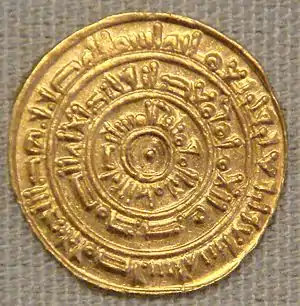 |
al-Mustansir Billah | Abū Tamīm Maʿad al-Mustanṣir biʾllāh | 1029 | 13 June 1036 | 29 December 1094 | ||
| al-Musta'li Billah | Abū al-Qāsim Aḥmad ibn al-Mustanṣir | 1074 | 29/30 December 1094 | 11/12 December 1101 | |||
| al-Amir bi-Ahkam Allah | Abū ʿAlī al-Manṣūr ibn al-Mustaʿlī | 1096 | 11 December 1101 | 7 October 1130 | |||
| al-Hafiz li-Din Allah | Abūʾl-Maymūn ʿAbd al-Majīd ibn Muḥammad ibn al-Mustanṣir | 1074/5 or 1075/6 | 23 January 1132 | 10 October 1149 |
| ||
| al-Ẓāfir bi-Aʿdāʾ Allāh | Abū al-Manṣūr Ismāʿīl ibn al-Ḥāfiẓ | 1133 | 10 October 1149 | 1 or 15 April 1154 | |||
| al-Fa'iz bi-Nasr Allah | Abūʾl-Qāsim ʿĪsā ibn al-Ẓāfir | 1149 | 16 April 1154 | 22 July 1160 | |||
| al-ʿĀḍid li-Dīn Allāh | Abū Muḥammad ʿAbd Allāh ibn Yūsuf | 1151 | 23 July 1160 | 13 September 1171 |
| ||
Caliphate of Córdoba (929–1031)
(Not universally accepted; actual authority confined to Spain and parts of Maghreb)[18][19]
| Name | Reign | Parents |
|---|---|---|
| Abd-ar-Rahman III | 929–961 |
|
| Al-Hakam II | 961–976 |
|
| Hisham II al-Hakam | 976–1009 | |
| Muhammad II | 1009 |
|
| Sulayman ibn al-Hakam | 1009–1010 |
|
| Hisham II al-Hakam | 1010–1013 | |
| Sulayman ibn al-Hakam | 1013–1016 |
|
| Abd ar-Rahman IV | 1021–1022 |
|
| Abd ar-Rahman V | 1022–1023 |
|
| Muhammad III | 1023–1024 |
|
| Hisham III | 1027–1031 |
|
Almohad Caliphate (1145–1269)
(Not widely accepted, actual dominions were parts of North Africa and Iberia)[20][21]
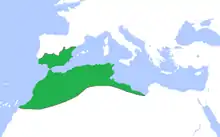
- Ibn Tumart 1121–1130
- Abd al-Mu'min 1130–1163
- Abu Ya'qub Yusuf I 1163–1184
- Abu Yusuf Ya'qub 'al-Mansur' 1184–1199
- Muhammad al-Nasir 1199–1213
- Abu Ya'qub Yusuf II 'al-Mustansir' 1213–1224
- Abu Muhammad Abd al-Wahid I 'al-Makhlu' 1224
- Abdallah al-Adil 1224–1227
- Yahya 'al-Mutasim' 1227–1229
- Abu al-Ala Idris I al-Ma'mun, 1229–1232
- Abu Muhammad Abd al-Wahid II 'al-Rashid' 1232–1242
- Abu al-Hassan Ali 'al-Said' 1242–1248
- Abu Hafs Umar 'al-Murtada', 1248–1266
- Abu al-Ula (Abu Dabbus) Idris II 'al-Wathiq' 1266–1269
| Almohad family tree | |||||||||||||||||||||||||||||||||||||||||||||||||||||||||||||||||||||||||||||||||||||||||||||||||||||||||||||||||||||||||||||||||||||||||||||||||||||||||||||||||||||||||||||||||||||||||||||||||||||||||||||||||||||||||||||||||||||||||||||||||||||||||||||||||||||||||||||||||||||||||||||||||||||||||||||||||||||||||||||||||||||||||||||||||||||||||||||||||||||||||||||||||||||||||||||||||||||||||||||||||||||||||||||||||||||||||||||||||||||||||||||||||||||||||||||||||||||||||||||||||||||||||||||||||||||||||||||||||||||||||||||||||||||||||||||||||||||||||||||||||||||||||||||||||||||||||||||||||||||||||||||||||||||||||||||||||||||||||||||||||||||||||||||||||||||||||||||||||||||||||||||||||||||||||||||||||||||||||||||||||||||||||||||||||||||||||||||||||||||||||||||||||||||||||||||||||||||||||||||||||||||||||||||||||||||||||||||||||||||||||||||||||||||||||||||||||||||||||||||||||||||||||||||||||||||||||||||||||||||||||||||||||||||||||||||||||||||||||||||||||||||||||||||||||||||||||||||||||||||||
|---|---|---|---|---|---|---|---|---|---|---|---|---|---|---|---|---|---|---|---|---|---|---|---|---|---|---|---|---|---|---|---|---|---|---|---|---|---|---|---|---|---|---|---|---|---|---|---|---|---|---|---|---|---|---|---|---|---|---|---|---|---|---|---|---|---|---|---|---|---|---|---|---|---|---|---|---|---|---|---|---|---|---|---|---|---|---|---|---|---|---|---|---|---|---|---|---|---|---|---|---|---|---|---|---|---|---|---|---|---|---|---|---|---|---|---|---|---|---|---|---|---|---|---|---|---|---|---|---|---|---|---|---|---|---|---|---|---|---|---|---|---|---|---|---|---|---|---|---|---|---|---|---|---|---|---|---|---|---|---|---|---|---|---|---|---|---|---|---|---|---|---|---|---|---|---|---|---|---|---|---|---|---|---|---|---|---|---|---|---|---|---|---|---|---|---|---|---|---|---|---|---|---|---|---|---|---|---|---|---|---|---|---|---|---|---|---|---|---|---|---|---|---|---|---|---|---|---|---|---|---|---|---|---|---|---|---|---|---|---|---|---|---|---|---|---|---|---|---|---|---|---|---|---|---|---|---|---|---|---|---|---|---|---|---|---|---|---|---|---|---|---|---|---|---|---|---|---|---|---|---|---|---|---|---|---|---|---|---|---|---|---|---|---|---|---|---|---|---|---|---|---|---|---|---|---|---|---|---|---|---|---|---|---|---|---|---|---|---|---|---|---|---|---|---|---|---|---|---|---|---|---|---|---|---|---|---|---|---|---|---|---|---|---|---|---|---|---|---|---|---|---|---|---|---|---|---|---|---|---|---|---|---|---|---|---|---|---|---|---|---|---|---|---|---|---|---|---|---|---|---|---|---|---|---|---|---|---|---|---|---|---|---|---|---|---|---|---|---|---|---|---|---|---|---|---|---|---|---|---|---|---|---|---|---|---|---|---|---|---|---|---|---|---|---|---|---|---|---|---|---|---|---|---|---|---|---|---|---|---|---|---|---|---|---|---|---|---|---|---|---|---|---|---|---|---|---|---|---|---|---|---|---|---|---|---|---|---|---|---|---|---|---|---|---|---|---|---|---|---|---|---|---|---|---|---|---|---|---|---|---|---|---|---|---|---|---|---|---|---|---|---|---|---|---|---|---|---|---|---|---|---|---|---|---|---|---|---|---|---|---|---|---|---|---|---|---|---|---|---|---|---|---|---|---|---|---|---|---|---|---|---|---|---|---|---|---|---|---|---|---|---|---|---|---|---|---|---|---|---|---|---|---|---|---|---|---|---|---|---|---|---|---|---|---|---|---|---|---|---|---|---|---|---|---|---|---|---|---|---|---|---|---|---|---|---|---|---|---|---|---|---|---|---|---|---|---|---|---|---|---|---|---|---|---|---|---|---|---|---|---|---|---|---|---|---|---|---|---|---|---|---|---|---|---|---|---|---|---|---|---|---|---|---|---|---|---|---|---|---|---|---|---|---|---|---|---|---|---|---|---|---|---|---|---|---|---|---|---|---|---|---|---|---|---|---|---|---|---|---|---|---|---|---|---|---|---|---|---|---|---|---|---|---|---|---|---|---|---|---|---|---|---|---|---|---|---|---|---|---|---|---|---|---|---|---|---|---|---|---|---|---|---|---|---|---|---|---|---|---|---|---|---|---|---|---|---|---|---|---|---|---|---|---|---|---|---|---|---|---|---|---|---|---|---|---|---|---|---|---|---|---|---|---|---|---|---|---|---|---|---|---|---|---|---|---|---|---|---|---|---|---|---|---|---|---|---|---|---|---|---|---|---|---|---|---|---|---|---|---|---|---|---|---|---|---|---|---|---|---|---|---|---|---|---|---|---|---|---|---|---|---|---|---|---|---|---|---|---|---|---|---|---|---|---|---|---|---|---|---|---|---|---|---|---|---|---|---|---|---|---|---|---|---|---|---|---|---|---|---|---|---|---|---|---|---|---|---|---|---|---|---|---|---|---|---|---|---|---|---|---|---|---|---|---|---|---|---|---|---|---|---|---|---|---|---|---|---|---|---|---|---|---|---|---|---|---|---|---|---|---|---|---|---|---|---|---|---|---|---|---|---|---|---|---|---|---|---|---|---|---|---|---|---|---|---|---|---|---|---|---|---|---|---|---|---|---|---|---|---|---|---|---|---|---|---|---|---|---|---|---|---|---|---|---|---|---|---|---|---|---|---|---|---|---|---|---|---|---|---|---|---|---|---|---|---|---|---|---|---|---|---|---|---|---|---|---|---|---|---|
| |||||||||||||||||||||||||||||||||||||||||||||||||||||||||||||||||||||||||||||||||||||||||||||||||||||||||||||||||||||||||||||||||||||||||||||||||||||||||||||||||||||||||||||||||||||||||||||||||||||||||||||||||||||||||||||||||||||||||||||||||||||||||||||||||||||||||||||||||||||||||||||||||||||||||||||||||||||||||||||||||||||||||||||||||||||||||||||||||||||||||||||||||||||||||||||||||||||||||||||||||||||||||||||||||||||||||||||||||||||||||||||||||||||||||||||||||||||||||||||||||||||||||||||||||||||||||||||||||||||||||||||||||||||||||||||||||||||||||||||||||||||||||||||||||||||||||||||||||||||||||||||||||||||||||||||||||||||||||||||||||||||||||||||||||||||||||||||||||||||||||||||||||||||||||||||||||||||||||||||||||||||||||||||||||||||||||||||||||||||||||||||||||||||||||||||||||||||||||||||||||||||||||||||||||||||||||||||||||||||||||||||||||||||||||||||||||||||||||||||||||||||||||||||||||||||||||||||||||||||||||||||||||||||||||||||||||||||||||||||||||||||||||||||||||||||||||||||||||||||||
Bornu and Songhai Empires (15th/16th century)


Several rulers of West Africa adopted the title of Caliph. Mai Ali Ghaji ibn Dunama was the first ruler of Bornu Empire to assume the title. Askia Mohammad I of Songhai Empire also assumed the title around the same time.[22]
Indian caliphates (late medieval/early modern)
Since the 12th century, despite the South Asian domination of numerous Muslim empires, kingdoms and sultanates, Islamic caliphates were not fully attempted to be established across the Indian subcontinent. However, under the sharia based reigns of Sunni emperors such as Alauddin Khalji, Mughal Empire's Aurangzeb, and Mysore's rulers Hyder Ali and Tipu Sultan, absolute forms of caliphates were clearly to have appeared. These largely impacted the French-Italian emperor Napoleone Bonaparte and soldiers of the British Empire.[23][24][25][26]
Sokoto Caliphate (1804–1903)

(Not widely accepted, actual dominions were parts of West Africa)
Established by Tariqa Islamic scholar and religious leader Usman dan Fodio through the Fulani War (alternatively known as the Fulani Jihad), which sought to reduce the influence of pre-Islamic religious practices and spread a more vigorous form of Islam through the auspices of a Caliphate.
Sharifian Caliphate (1924–1925)

A last attempt at restoring the caliphal office and style with ecumenical recognition was made by Hussein bin Ali, King of Hejaz and Sharif of Mecca, who assumed both on 11 March 1924 and held them until 3 October 1924, when he passed the kingship to his son `Ali ibn al-Husayn al-Hashimi, who did not adopt the caliphal office and style.[27] Like the Fatimid caliphs, he was a descendant of Muhammad through a grandson of Hasan ibn Ali. Hussein's claim for caliphate was not accepted by the Wahhabi and Salafi movements, and in 1925 he was driven from Hejaz by the forces of Ibn Saud as an outcome of the Second Saudi-Hashemite War. He continued to use the title of caliph during his remaining life in exile, until his death in 1931.
Islamic State (2014–present)
On 29 June 2014, the Islamic State proclaimed the return of the Islamic caliphate, with its first caliph as Amir al-Mu'minin Abu Bakr Ibrahim bin Awwad Al-Badri Al-Husaini Al-Hashimi Al-Quraishi As-sammera'i al-Baghdadi.[28][29] The caliphate's claimed territory at its peak controlled 12 million people. At its height, Islamic State ruled territories in various countries including Iraq, Syria, Lebanon, Nigeria, Libya, the Philippines, Afghanistan, Congo, Yemen, and the Sinai region in Egypt, in addition to running guerrilla cells in many other countries.[30][31]
In 2014–15, dozens of Salafi Jihadi groups[32] and scholars[33] around the world pledged allegiance to ISIL claimed Caliphate.
On 10 April 2018, during a rally of U.S. President Donald Trump in Elkhart, Indiana in support of Mike Braun’s bid for the US Senate, Vice President Mike Pence referred to ISIS as a Caliphate, claiming "ISIS is on the run, their Caliphate has crumbled, and we will soon drive them out of existence once and for all."[34]
The Islamic State of Islamic State of Iraq and the Levant, the militant jihadist organization prescribed by many states as a terrorist organization, and the founding organization of the Islamic State caliphate. Were severely degraded in operational capability, subscribers and territorial control during the military intervention in Iraq and Syria by the U.S.-led Global Coalition to Defeat Daesh, and in Syria by the military of the Russian Federation.[35]
As of early, 2022 Islamic State occupies some territory in Nigeria and has 3 million people under its rule;[36] and also it continues to maintain control over some rural uninhabited areas in both Iraq and Syria[37][38]
| No. | Image | Caliph | Date of birth | Reigned from | Reigned until |
|---|---|---|---|---|---|
| 1 |  |
Abu-Bakr Ibrahim bin Awwad al-Baghdadi | 28 July 1971 | 29 June 2014 | 27 October 2019 |
| 2 |  |
Abu-Ibrahim Al-Hashimi Al-Quraishi | October 1976 | 31 October 2019 | 3 February 2022 |
| 3 |  |
Abu al-Hasan al-Hashimi al-Qurashi | Unknown | 10 March 2022 | 15 October 2022 |
| 4 | Abu al-Hussein al-Husseini al-Qurashi | Unknown | 30 November 2022 | 29 April 2023 | |
| 5 | Abu Hafs al-Hashimi al-Qurashi | Unknown | 3 August 2023 | Present |
See also
Notes
- ↑ Abdulmejid II, the last Ottoman Caliph, lacked a tughra of his own, since he did not serve as head of state (that position being held by Mustafa Kemal, President of the newly founded Republic of Turkey) but as a religious and royal figurehead.
References
- 1 2 The New Encyclopædia Britannica, 15th ed., Encyclopædia Britannica, Inc., 1998, ISBN 0-85229-663-0, Vol. 10, p. 738
- ↑ Duncan S. Ferguson (2010). Exploring the Spirituality of the World Religions: The Quest for Personal, Spiritual and Social Transformation. Bloomsbury Academic. p. 192. ISBN 978-1-4411-4645-8.
- ↑ Duncan S. Ferguson (2010). Exploring the Spirituality of the World Religions: The Quest for Personal, Spiritual and Social Transformation. Bloomsbury Academic. p. 192. ISBN 978-1-4411-4645-8.
- ↑ Jazeera, Al. "The Caliph". interactive.aljazeera.com. Retrieved 2023-04-06.
- ↑ McQuaid, Julia Voelker (September 2007). "The Struggle for Unity and Authority in Islam: Reviving the Caliphate?" (PDF). Center for Strategic Studies: 1.
- ↑ "Successors to the prophet: Islam's caliphates". The Seattle Times. 2014-07-01. Retrieved 2023-04-06.
- ↑ Ekinci, Ekrem Buğra (2017-03-03). "The rise and fall of the Islamic caliphate in history". Daily Sabah. Retrieved 2023-04-06.
- ↑ Office of the 33rd Lead Inspector General of the United States Department of Defense (May 2023) "OPERATION INHERENT RESOLVE LEAD INSPECTOR GENERAL REPORT TO THE UNITED STATES CONGRESS" (PDF) Retrieved 2023-05-04
- ↑ "The Umayyad Caliphate: The Largest Islamic State". TheCollector. 2022-11-01. Retrieved 2023-04-06.
- ↑ Saïd Amir Arjomand, Abd Allah Ibn al-Muqaffa and the Abbasid Revolution. Iranian Studies, vol. 27, Nos. 1–4. London: Routledge, 1994.
- ↑ Bosworth 2004, p. 7
- ↑ Houtsma & Wensinck 1993, p. 3
- ↑ Lane-Poole 2004, p. 195
- ↑ Bosworth 2004, pp. 239–240
- ↑ Lambton, Ann; Lewis, Bernard (1995). The Cambridge History of Islam: The Indian sub-continent, South-East Asia, Africa and the Muslim west. Vol. 2. Cambridge University Press. p. 320. ISBN 9780521223102. Retrieved 14 March 2015.
- ↑ As̜iroğlu 1992, p. 13
- ↑ Dictionary of Battles and Sieges: F-O edited by Tony Jacques
- ↑ Lane-Poole 2004, p. 21
- ↑ Bosworth 2004, p. 11
- ↑ Lane-Poole 2004, p. 47
- ↑ Bosworth 2004, p. 39
- ↑ Nehemia Levtzion; Randall Pouwels. The History of Islam in Africa. Ohio University Press. p. 81.
- ↑ Jackson, Roy (2010). Mawlana Mawdudi and Political Islam: Authority and the Islamic State. Routledge. ISBN 9781136950360.
- ↑ Shah Muhammad Waseem (2003): هندوستان ميں فارسى تاريخ نگارى: ٧١ويں صدى كے آخرى نصف سے ٨١ويں صدى كے پهلے نصف تک فارسى تاريخ نگارى كا ارتقاء, Kanishka Publishing, original source from the University of Michigan ISBN 9788173915376
- ↑ Hussein, S M (2002). Structure of Politics Under Aurangzeb 1658–1707. Kanishka Publishers Distributors (2002). ISBN 978-8173914898.
- ↑ Banarsi Prasad Saksena (1992) [1970]. "The Khaljis: Alauddin Khalji". In Mohammad Habib and Khaliq Ahmad Nizami (ed.). A Comprehensive History of India: The Delhi Sultanat (A.D. 1206–1526). Vol. 5 (Second ed.). The Indian History Congress / People's Publishing House. OCLC 31870180.
- ↑ Bosworth 2004, p. 118
- ↑ Adam Withnall (2014-06-30). "Iraq crisis: Isis declares its territories a new Islamic state with 'restoration of caliphate' in Middle East – Middle East – World". The Independent. Retrieved 2014-07-04.
- ↑ "ISIS Spokesman Declares Caliphate, Rebrands Group as "Islamic State"". SITE Institute. 29 June 2014. Retrieved 29 June 2014.
- ↑ "Islamic State-controlled parts of Syria, Iraq largely out of reach: Red Cross". Reuters. 13 March 2015.
- ↑ Yusuf al-Qaradawi stated: "[The] declaration issued by the Islamic State is void under sharia and has dangerous consequences for the Sunnis in Iraq and for the revolt in Syria", adding that the title of caliph can "only be given by the entire Muslim nation", not by a single group. Strange, Hannah (5 July 2014). "Islamic State leader Abu Bakr al-Baghdadi addresses Muslims in Mosul". The Telegraph. Archived from the original on 2022-01-12. Retrieved 6 July 2014.
- ↑ Power rankings April 2015
- ↑ "A Jihadi Civil War of Words: The Ghuraba' Media Foundation and Minbar al-Tawhid wa'l-Jihad".
- ↑ Trump TV Network (2018-05-10), FULL EVENT: President Donald Trump MASSIVE Rally in Elkhart, Indiana – May 10, 2018, archived from the original on 2018-05-10, retrieved 2018-05-12. See 6:00
- ↑ Office of the 33rd Lead Inspector General of the United States Department of Defense (May 2023) "OPERATION INHERENT RESOLVE LEAD INSPECTOR GENERAL REPORT TO THE UNITED STATES CONGRESS" (PDF) Retrieved 2023-05-04
- ↑ "After Shekau: Confronting Jihadists in Nigeria's North East". 29 March 2022.
- ↑ "5 ISIS Enclaves Remain in Central, Eastern Syria".
- ↑ "IS's concern continues to be maintaining control in places like the Muqdadiya and Khanaqin districts, Hawija, and Tarmiya https://musingsoniraq.blogspot.com/2023/02/violence-drops-in-iraq-in-january-2023.html
Bibliography
- Bosworth, C. E., ed. (1987). The History of al-Ṭabarī, Volume XXXII: The Reunification of the ʿAbbāsid Caliphate: The Caliphate of al-Maʾmūn, A.D. 813–33/A.H. 198–213. SUNY Series in Near Eastern Studies. Albany, New York: State University of New York Press. ISBN 978-0-88706-058-8.
- Bosworth, Clifford Edmund (2004) [1996]. The New Islamic Dynasties: A Chronological and Genealogical Manual. New Edinburgh Islamic Surveys (2nd ed.). Edinburgh University Press. ISBN 978-0-7486-2137-8. OCLC 56639413.
- Wellhausen, Julius (1927). The Arab Kingdom and Its Fall. Translated by Margaret Graham Weir. Calcutta: University of Calcutta. OCLC 752790641.
- Lammens, H. & Blankinship, Kh. Y. (2002). "Yazīd (II) b. ʿAbd al-Malik". In Bearman, P. J.; Bianquis, Th.; Bosworth, C. E.; van Donzel, E. & Heinrichs, W. P. (eds.). Encyclopaedia of Islam. Volume XI: W–Z (2nd ed.). Leiden: E. J. Brill. p. 311. ISBN 978-90-04-12756-2.
- Powers, David S., ed. (1989). The History of al-Ṭabarī, Volume XXIV: The Empire in Transition: The Caliphates of Sulaymān, ʿUmar, and Yazīd, A.D. 715–724/A.H. 96–105. SUNY Series in Near Eastern Studies. Albany, New York: State University of New York Press. ISBN 978-0-7914-0072-2.
- Bosworth, C.E. (1993). "Al-Muntasir". In Bosworth, C. E.; van Donzel, E.; Heinrichs, W. P. & Pellat, Ch. (eds.). Encyclopaedia of Islam. Volume VII: Mif–Naz (2nd ed.). Leiden: E. J. Brill. ISBN 978-90-04-09419-2.
- Bobrick, Benson (2012). The Caliph's Splendor: Islam and the West in the Golden Age of Baghdad. Simon & Schuster. ISBN 978-1416567622.
- Houtsma, M. Th.; Wensinck, A. J. (1993). E.J. Brill's First Encyclopaedia of Islam 1913–1936. Vol. IX (Reprint ed.). Leiden: BRILL. ISBN 978-90-04-09796-4.
- Kennedy, Hugh (2006). When Baghdad Ruled the Muslim World: The Rise and Fall of Islam's Greatest Dynasty. Cambridge, MA: Da Capo Press. ISBN 978-0-306814808.
- Lane-Poole, Stanley (1894). The Mohammedan Dynasties: Chronological and Genealogical Tables with Historical Introductions. Westminster: Archibald Constable and Company. OCLC 1199708.
- Zetterstéen, K. V. (1987). "al-Muʿtaḍid Bi'llāh". In Houtsma, Martijn Theodoor (ed.). E.J. Brill's First Encyclopaedia of Islam, 1913–1936, Volume VI: Morocco–Ruzzik. Leiden: Brill. p. 777. ISBN 978-90-04-08265-6.
